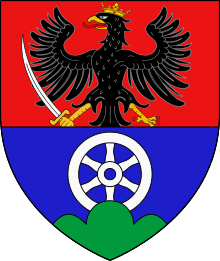Rákóczi


The Rákóczi (older spelling Rákóczy) were a Hungarian noble family in the Kingdom of Hungary between the 13th century and 18th century. Their name is also spelled Rakoci (in Slovakia), Rakoczi and Rakoczy in some foreign (English) sources.
The family originated from the Bogátradvány clan which had Bohemian roots, according to Simon of Kéza's chronicle. The foundations for the family's wealth and power were laid down by Sigismund Rákóczi; some decades into the 17th century, the Rákóczis became the wealthiest aristocrats of Hungary.[2]
Family legacy
The last member of the family was György (George) Rákóczi, the son of Francis II Rákóczi, who died in France in 1756.
The mysterious Count of St. Germain is believed by some to have been the son of Prince Francis (Ferenc) II Rákóczi.
The Rákóczi March by János Bihari and (memorably orchestrated by Hector Berlioz) refers to them.
The Hungarian Rhapsody No. 15 by Franz Liszt refers to the rebellion led by Francis II Rákóczi.
History
Sigismund Rakoczi
Sigismund Rakoczi briefly reigned as Prince of Transylvania from 1607 to 1608.
George I Rakoczi
George I Rakoczi (Born June 8, 1593, Szerencs – Oct. 11, 1648) was the prince of Transylvania from 1630. In 1643, Rákóczi formed an alliance with Sweden. In February 1644, leading a 30,000-man army, he launched a campaign against the Habsburgs in the Thirty Years’ War. Peasants who struggled for national liberation in the Kingdom of Hungary supported him. He also encouraged the development of the mining industry and commerce.[3]
George II Rakoczy
George II Rakoczi (30 January 1621, Hungary – June 7, 1660) was a Hungarian nobleman and prince of Transylvania (1648- 1660). In 1657, he led an army of 40,000 men against King John II Casimir of Poland in the third part of the Second Northern War (1655-1660). He took Kraków and entered Warsaw with the Swedes, but the moment his allies withdrew, he was defeated by the Poles at Czarny Ostrów. Finally, the Poles allowed him to return to Transylvania. When the Turks invaded Transylvania, he died at the battle of Gyalu (Gilău) (May 1660).
Francis I Rakoczy
Francis I Rakoczi (February 24, 1645, Gyulafehérvár, Transylvania – July 8, 1676, Zboró,Royal Hungary) was the elected prince of Transylvania and Hungarian aristocrat. He was the son of George II Rakoczi, who was the prince of Transylvania, though George transferred his power to his son in 1652 through the Transylvanian Diet. However, Francis was never able to occupy this role because the Ottoman government prohibited Rakoczi inheritance of the Transylvanian throne in 1660. Francis therefore lived as an aristocrat in Royal Hungary.
In terms of religion, Francis I broke with the Calvinist Rakoczi tradition by converting to Catholicism in imitation of his mother, Zsófia Báthori, which gained him favor with the Catholic Habsburg Court.
Francis I married Hungarian countess Helen Zrínyi in 1666 and had three children, György (1667); Julianna Borbála (1672–1717); and Francis II (1676–1735). He soon joined the Wesselenyi Conspiracy as a result of his marriage to Zrínyi. He became the leader of this group and attempted to stage an uprising among Hungarian nobles, but this was poorly organized and was soon crushed by the Austrian government.
Francis II Rakoczy
Francis II Rakoczi (March 27, 1676, Borsi, Hungary - April 8, 1735, Rodusto, Turkey), also known as Ferenc II Rakoczi, was the prince of Transylvania and leader of the last major Hungarian uprising against Austria until 1848. He is celebrated as a national hero in Hungary.
Francis was raised by Austrian standards and attended a Jesuit college in Bohemia, though he was majorly influenced by the nationalist fervor of his family growing up. Francis returned to his estates in Hungary in 1694 and was elected prince of Transylvania in 1704.[4]
Around the turn of the 18th century, French monarch Louis XIV sought out Rakoczi’s help in their attempt to reduce Austrian power and promised to aid Rakoczi in return for an attempt at Hungarian independence. However, Rakoczi was arrested in 1700 after an Austrian spy alerted the emperor. He escaped to Poland and at the start of the War of the Spanish Succession, he led a Kuruc uprising in an attempt to gain Hungarian independence, leading to the War for Independence.
However, the war failed, and Francis left Hungary forever in 1711, living in Turkey. He is commemorated by statues and monuments throughout Hungary, as well as in the Rakoczi March.
Major events
War for Independence
In 1678, anti-Habsburg revolutionaries led by Imre Thököly and aided by Louis XIV of France and the Ottomans rose in uprising against the Habsburgs. After the failed Battle of Vienna in 1683, Thököly lost support and was defeated in 1685.
Around 1700, Louis XIV reached out again, this time to Francis II Rakoczi, in his attempt to mitigate Austrian power. Francis was arrested for this correspondence but eventually escaped to Poland. The War of the Spanish Succession forced much of the Austrian army to leave Hungary, creating an opportunity to revolt. The Kurucs, or the anti-Habsburg rebels, began an uprising headed by Rakoczi. However, very few nobles supported the revolution. Additionally, Austrian military victories over the French and the Bavarians caused aid to the revolution to falter. By 1706, Rakoczi was forced to retreat. Peace negotiations were largely unsuccessful, and Hungarian defeat at the Battle of Trencsén solidified Austrian victory.[5]
References
- ↑ Rákóczi Castle accessed 23 October 2006
- ↑ Roman, Eric (2003). Austria-Hungary & the successor states: a reference guide from the Renaissance to the present. Infobase Publishing. p. 161.
- ↑ George I, The Great Soviet Encyclopedia, 1979
- ↑ Ferenc Rakoczi II, Encyclopedia Britannica, n.d.
- ↑ McKay, John P. and Others. A History of Western Society: Since 1300. Boston: Bedford/St. Martin’s, 2011, 495.
External links
| Wikimedia Commons has media related to Rákóczi family. |
- Marek, Miroslav. "hung/rakoczi1.html". Genealogy.euweb.cz.
| ||||||||||||||||||||
.svg.png)